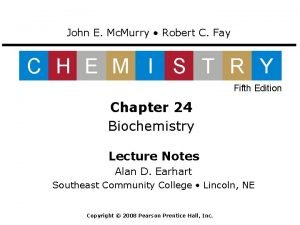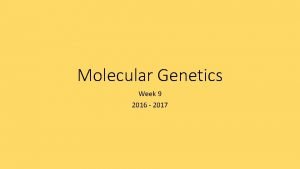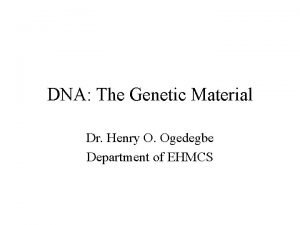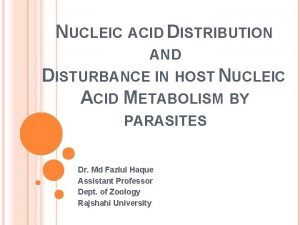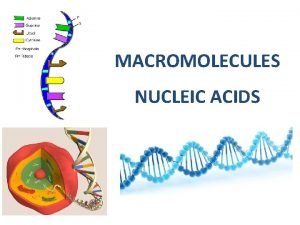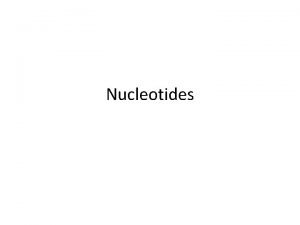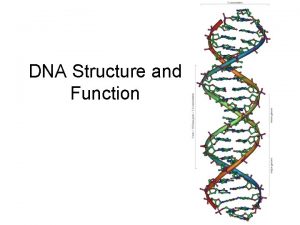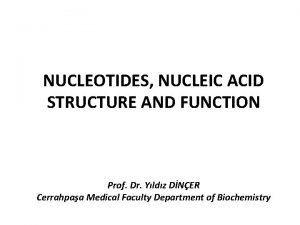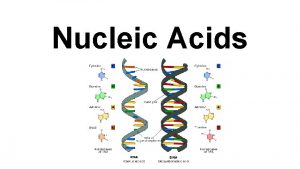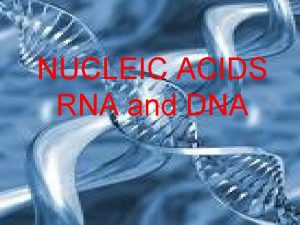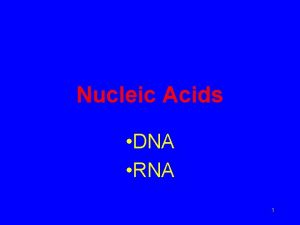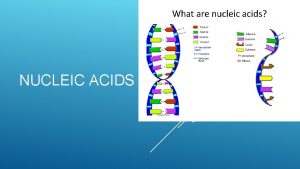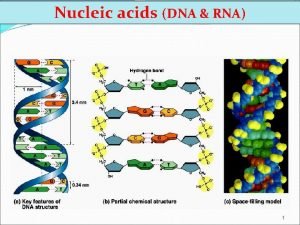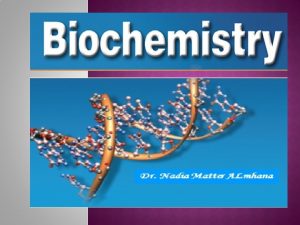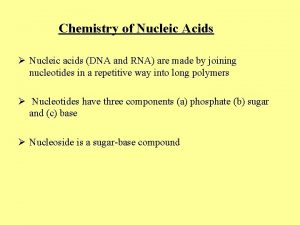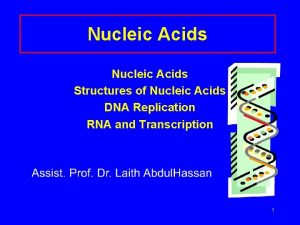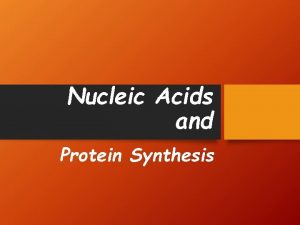Nucleic Acids DNA RNA What do they do














- Slides: 14

Nucleic Acids DNA & RNA

What do they do ? Dictate amino-acid sequence in proteins Give information to chromosomes, which is then passed from parent to offspring

What are they ? th 4 The type of macromolecules The chemical link between generations The source of genetic information in chromosomes

The central dogma of molecular biology.

Nucleic Acids and Heredity • Processes in the transfer of genetic information: • Replication: identical copies of DNA are made • Transcription: genetic messages are read and carried out of the cell nucleus to the ribosomes, where protein synthesis occurs. • Translation: genetic messages are decoded to make proteins.

The nucleus contains the cell’s DNA (genome) RNA is synthesized in the nucleus and exported to the cytoplasm Nucleus Cytoplasm replication DNA transcription RNA (m. RNA) translation Proteins

Two types of Nucleotides (depending on the sugar they contain) 1 - Ribonucleic acids (RNA) The pentose sugar is Ribose (has a hydroxyl group in the 3 rd carbon ---OH) 2 - Deoxyribonucleic acids (DNA) The pentose sugar is Deoxyribose (has just an hydrogen in the same place--- H) Deoxy = “minus oxygen”

Definitions Nucleic acids are polymers of nucleotides Nucleotides are carbon ring structures containing nitrogen linked to a 5 -carbon sugar (a ribose) 5 -carbon sugar is either a ribose or a deoxy-ribose making the nucleotide either a ribonucleotide or a deoxyribonucleotide In eukaryotic cells nucleic acids are either: Deoxyribose nucleic acids (DNA) Ribose nucleic acids (RNA) Messenger RNA (m. RNA) Transfer RNA (t. RNA) Ribosomal RNA (t. RNA)

Nucleic Acid Function DNA Genetic material - sequence of nucleotides encodes different amino acids RNA Involved in the transcription/translation of genetic material (DNA) Genetic material of some viruses

Nucleotide Structure Despite the complexity and diversity of life the structure of DNA is dependent on only 4 different nucleotides Diversity is dependent on the nucleotide sequence All nucleotides are 2 ring structures composed of: 5 -carbon sugar : b-D-ribose (RNA) b-D-deoxyribose (DNA) Base Purine Pyrimidine Phosphate group A nucleotide WITHOUT a phosphate group is a NUCLEOSIDE

NUCLEIC ACIDS (DNA and RNA) Notes DNA – Deoxyribonucleic Acid • DNA controls all living processes including production of new cells – cell division • DNA carries the genetic code – stores and transmits genetic information from one generation to the next • Chromosomes are made of DNA • DNA is located in the nucleus of the cell

Nucleotides and Nucleosides • Nucleotide = • Nitrogeneous base • Pentose • Phosphate • Nucleoside = • Nitrogeneous base • Pentose • Nucleobase = • Nitrogeneous base

What are they made of ? • Simple units called nucleotides, connected in long chains • Nucleotides have 3 parts: 1 - 5 -Carbon sugar (pentose) 2 - Nitrogen containing base (made of C, H and N) 3 - A phosphate group ( P ) • The P groups make the links that unite the sugars (hence a “sugar-phosphate backbone”

 Dna rna protein synthesis homework #2 dna replication
Dna rna protein synthesis homework #2 dna replication Hystonia
Hystonia Nucleic acids
Nucleic acids Function of nucleic acids
Function of nucleic acids Store and transmit genetic information
Store and transmit genetic information What is an anticodon
What is an anticodon Functions of nucleic acid
Functions of nucleic acid Ribonucleotide vs deoxyribonucleotide
Ribonucleotide vs deoxyribonucleotide Function of nucleic acids
Function of nucleic acids The building block of nucleic acids.
The building block of nucleic acids. Nucleotide vs nucleoside
Nucleotide vs nucleoside Alloburinol
Alloburinol Macromolecules
Macromolecules Nucleic acid monomer
Nucleic acid monomer Functions of nucleotides
Functions of nucleotides


